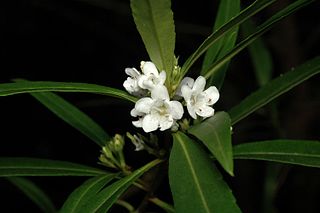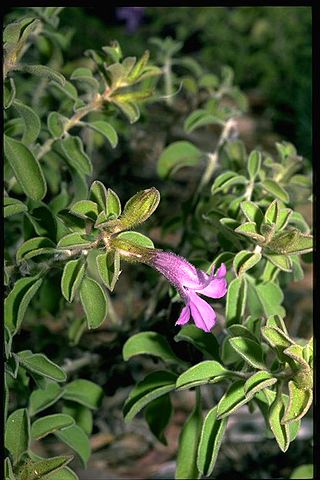
Eremophila debilis, the winter apple or amulla, is a flowering plant in the figwort family Scrophulariaceae, and is endemic to an area extending from north Queensland to near the border between New South Wales and Victoria in Australia. It is a prostrate shrub with elliptic to lance-shaped or egg-shaped leaves and white, rarely deep mauve flowers.

Eremophila cuneifolia, commonly known as pinyuru, is a flowering plant in the figwort family, Scrophulariaceae and is endemic to the north-west of Western Australia. It is a spreading, sticky shrub with wedge-shaped leaves, coloured sepals and usually deep purple flowers.

Myoporum parvifolium, commonly known as creeping boobialla, creeping myoporum, dwarf native myrtle or small leaved myoporum is a plant in the figwort family, Scrophulariaceae. It is a low, spreading shrub with long, trailing stems and white, star-shaped flowers and is endemic to southern Australia including Flinders Island.

Myoporum viscosum, commonly known as sticky boobialla, is a plant in the figwort family, Scrophulariaceae and is endemic to South Australia. It is unusual in that sometimes, especially when the leaves are crushed, it has an extremely unpleasant smell.

Myoporum betcheanum, commonly known as mountain boobialla is a plant in the figwort family, Scrophulariaceae. It is a shrub or small tree with long, narrow leaves that are a darker green on their upper surface than the lower. Its flowers have five white petals and are arranged in small groups in the leaf axils. The fruits which follow are more or less spherical, soft, cream coloured drupes. As its common name suggests, this plant is restricted to higher places, around 1,000 metres (3,000 ft) above sea level. It occurs in the McPherson Range and nearby mountains of New South Wales and Queensland.

Myoporum oppositifolium, commonly known as twin-leaf myoporum, is a plant in the figwort family, Scrophulariaceae. It is easily distinguished from others in the genus by the combination of glabrous leaves and branches, its opposite leaf arrangement and its serrated leaves. Its distribution is restricted to the extreme south-west of Western Australia.

Myoporum turbinatum, commonly known as salt myoporum, is a plant in the figwort family, Scrophulariaceae and is endemic to a small area near Esperance in Western Australia. It is closely related to Myoporum platycarpum but has much narrower leaves and differently shaped fruit. Its sticky branches and narrow, warty leaves are distinctive.

Myoporum velutinum is a plant in the figwort family, Scrophulariaceae and is endemic to a small area near Esperance in Western Australia. It has similar flowers and fruits and grows in similar environments to Myoporum tetrandrum but differs from it and all other members of the genus by having hairs on the outer edge of the petals.
Eremophila dendritica is a flowering plant in the figwort family, Scrophulariaceae and is endemic to the south of Australia. It is a low, shrub with many tangled branches. Its branches, leaves and flowers are densely covered with hairs giving them a felty texture.
Eremophila falcata is a flowering plant in the figwort family, Scrophulariaceae and is endemic to Western Australia. It is a widely distributed shrub with distinctive curved leaves and white, lilac-coloured or pink flowers.

Eremophila ovata is a flowering plant in the figwort family, Scrophulariaceae and is endemic to the Northern Territory. It is a small, spreading, rounded shrub with hairy branches and leaves and pink or purple flowers which are white inside.

Eremophila phyllopoda is a flowering plant in the figwort family, Scrophulariaceae and is endemic to Western Australia. It is an erect or spreading shrub, sometimes round or flat-topped with sticky, hairy leaves and flowers ranging in colour from pink or lilac to purple.
Eremophila prostrata, commonly known as Rainbow Valley fuchsia bush, is a flowering plant in the figwort family, Scrophulariaceae and is endemic to the Northern Territory. It is a prostrate shrub with glabrous branches and leaves and purple flowers. It occurs as a few scattered populations with a total area of less than 50 ha.

Eremophila pungens is a flowering plant in the figwort family, Scrophulariaceae and is endemic to Australia. It is an erect, sticky shrub with broad, serrated-edged leaves which end in a sharp spine and purple or violet flowers.

Eremophila reticulata is a flowering plant in the figwort family, Scrophulariaceae and is endemic to Western Australia. It is a dense shrub with egg-shaped leaves, colourful sepals and white or pink flowers.
Eremophila setacea is a flowering plant in the figwort family, Scrophulariaceae and is endemic to Western Australia. It is an erect shrub with narrow, glabrous leaves, hairy sepals and light blue to purple petals.
Eremophila simulans is a flowering plant in the figwort family, Scrophulariaceae and is endemic to Western Australia. It is an erect shrub with broad, serrated leaves and violet to purple flowers.

Eremophila stenophylla is a flowering plant in the figwort family, Scrophulariaceae and is endemic to Queensland. It is a broom-like shrub or small tree with narrow leaves and pink to brick-red flowers, which grows in the far south-west of the state.
Eremophila viscimarginata is a flowering plant in the figwort family, Scrophulariaceae and is endemic to Western Australia. It is a small, erect, prickly shrub with hairy stems, small leaves, greenish-pink sepals and mauve petals.

Eremophila warnesii is a flowering plant in the figwort family, Scrophulariaceae and is endemic to Western Australia. It is an erect, compact shrub with furry leaves, hairy sepals and blue to mauve petals. It is a little-known species, named after the founder of the Eremophila Study Group.














